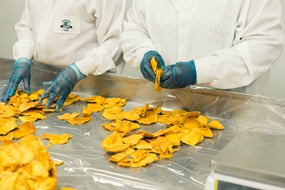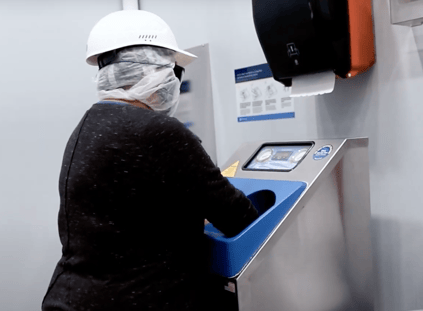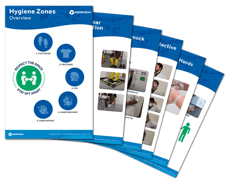Food Safety Culture Training: It's Easier Than You Think
If someone asked you to improve your workplace’s food safety culture training, you might first consider gathering all your coworkers and building a presentation on hygiene and the importance of being cognizant of your organization’s SOPs. But what comes next?
Building any type of workplace culture takes time and careful planning to fully resonate with an organization’s staff. One needs to have concrete goals when examining how to properly improve best practices. This can initially seem daunting. Fortunately, we have resources available to you that can help to set you on the right track to building a lasting food safety culture for your organization.
What is a Food Safety Culture?

Before we start discussing how to get a food safety culture implemented across your organization we must first understand exactly what a food safety culture is. In short, a Food Safety Culture is a unified mindset that places food safety and employee hygiene at the forefront of every aspect of the organization. An effective hygiene culture is one that views everything, from the layout of the facility to the employee’s individual personal hygiene through a lens of food safety.
For more information on how to define a Food Safety Culture, refer to our blog series here.
Building Consistency with S.A.V.E.
A great way to drive food safety culture consistency across your organization is to think of what we call the S.A.V.E. acronym. This stands for Standardize, Automate, Validate, and Educate. Utilizing these key steps can help you to always keep food culture at the forefront of your facility's operations.
Standardize
Standardization is really about consistency. If a standard process of hygiene is put into place, then that sets the foundation for your organization's food safety culture. It is therefore crucial to make sure that every process implemented is simple and easily to be understood by all employees. A simple standardized process develops that consistency from person to person and from facility to facility.
Processes that are easy to onboard and train into must also be considered. Employees that are introduced to these concepts early can become drivers of a healthy food safety culture in the workplace.
A great place to start when standardizing a food safety process is with a hygiene social contract. This sets the foundation for type of food safety culture that you are trying to build. This can include a set of rules and behaviors that set the expectations for your organization’s hygiene goals.
This social contract can act as a pinnacle piece of employee onboarding as well as a decision-making guide for when one is considering facility layouts, operational flows, and designing SOPs. You don’t have to make one from scratch. We have a Hygiene Social Contract that can act as a starting point for your organization and can be modified to meet your specific hygiene goals.
Automate

Automation makes it exponentially easier to standardize a hygiene process. With CleanTech® Automated Handwashing Stations, you no longer have to worry about policing the handwashing process of every one of your employees. Automation makes this process standardized for every single employee. The same hand wash is done for each person that places their hands in a CleanTech® Automated Handwashing Station for 12 seconds. Unlike manual handwashing, automated handwashing eliminates the possibility for employees to fall back on old habits of inadequate handwashing procedures that can be detrimental to a company's hygiene culture.
Validate
After you have implemented a new hygiene process it's crucial to validate how these new systems are functioning for your organization. One of our recent webinars included a poll that showed that 50% of people are not currently confident about their hygiene SOP's. One way to increase this confidence is to know what's working and what's not.
As we've mentioned, automation can help to alleviate the unknowns that come with manual handwashing, but to be certain a great way to test the efficacy of your hygiene methods is ATP testing. ATP tests are simple, cost effective measures that can show you exactly how automated handwashing is affecting the hygiene of your employees. It can also show you areas of your facility that may need additional food safety training based on the results of your hygiene zones.
Educate
Understanding why a new process is being put in place is pivotal to employee retention of hygiene expectations. The message of food safety must be filtered down through all levels of the facility so that if there are any questions or concerns, an employee can reach out to their nearest coworker to address those concerns.
This type of understanding is particularly important when new technologies are placed in a facility for better hygiene efficacy. For example, some employees may not immediately understand why a CleanTech® Automated Handwashing Station is easier to use and more effective than a traditional sink basin. After installation of these systems it is important to communicate why these systems will help to validate your organization’s food safety culture.
The More Visual, the Better
Once you have established S.A.V.E with your organization and educated your facility on the new processes that will help to improve your food safety culture, it is imperative that you keep hygiene at the forefront of your facility’s day to day activities. Posters are a great way of reminding your team about the new processes and provide a place of reference for when they might need to review hygiene best practices.
 We have a variety of food safety posters in our Employee Hygiene Toolbox that showcase key food safety procedures like dress codes and proper hand hygiene procedures that you can place in your facility around key egress points. These posters emphasize visual graphics over text so that all your employees, regardless of primary language, can understand.
We have a variety of food safety posters in our Employee Hygiene Toolbox that showcase key food safety procedures like dress codes and proper hand hygiene procedures that you can place in your facility around key egress points. These posters emphasize visual graphics over text so that all your employees, regardless of primary language, can understand.
Now that you have a better understanding of what is needed to lay the foundation for a food safety culture overhaul, you can easily begin the process of bettering your organization’s overall hygiene culture.






